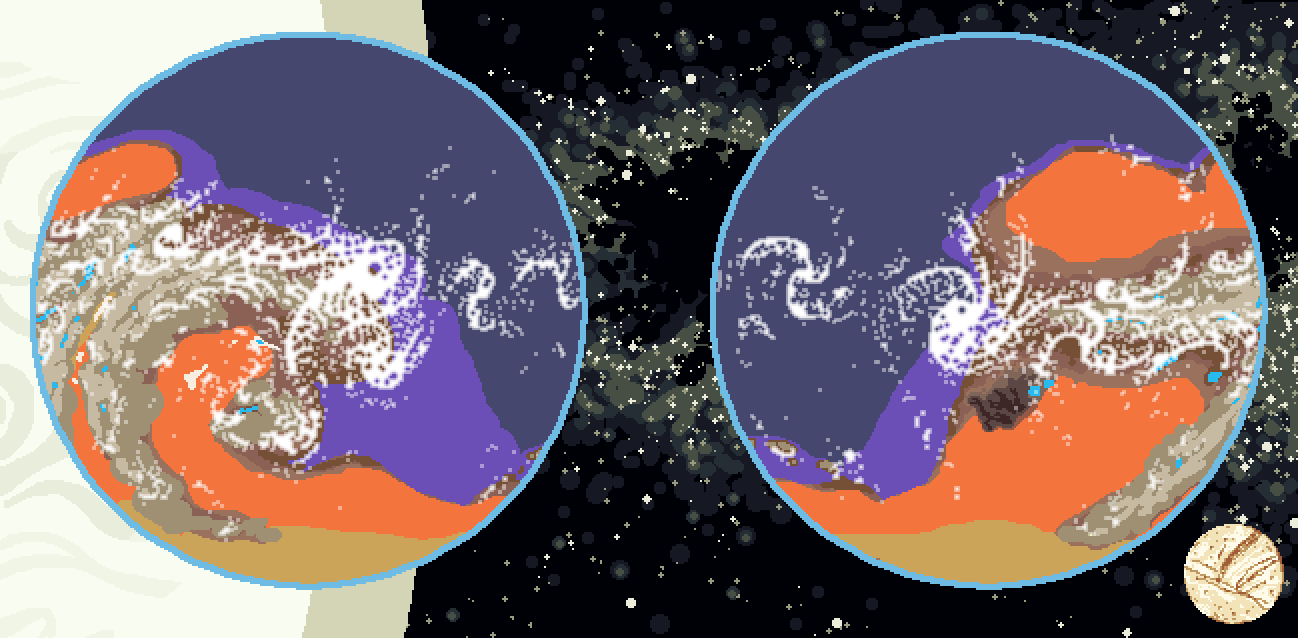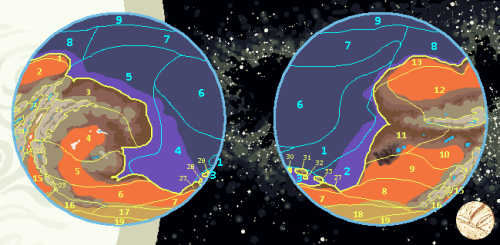Moon Iris (Cappu VI)
Moon Statistics
Length of orbit around parent planet: 52.8 hours
Stellar Year: 332 days on Earth, 94.9 days on Iris
Atmosphere:
Nitrogen: 81%
Oxygen: 18%
Carbon Dioxide: 600 ppm
Moon Description
Life
Unicellular life on Iris is diverse with many analogues to Earth unicellular life, however they are not currently being worked on in this project. This project focuses on the descendant genera and species branching off from four main starting multicellular species.Starting Species
Blugi was the first multicellular phototroph and is currently the universal common ancestor of all multicellular phototrophs on Iris. It was very similar to eukaryotic multicellular algae of Earth, including having a cell wall in most cases comprised partly of cellulose, and storing of starches as granules within the cytoplasm. They have diversified into every habitat with access to water and sun, but are absent from dark places such as caves and ocean depths.
Many decomposers on iris are bacteria-like and practically prokaryotes. However some decomposers are more complex and organized, such as the eukaryotic cufungus and it's descendants. A characteristic of all cufungus descendants (so far) is the sporing fruits they produce on the surface of the material their mycellium is decomposing. Another characteristic is their cell walls, supporting the complex networks of cells while avoiding breakage.
They assist with recycling of nutrients, soil formation and even provide homes for unicellular algae. However some forms have become parasitic and pathogenic to animals.
Spongill are multicellular animals comprised of microscopic hollow tubular tendrills lined with tiny stomachs and equipped by a mix of grabbing and water-propelling tentacles. These tendrills grow to form the macro-structure of the organism, tendrills clumping or tangling together to form the walls of the channels through which water is passed through to filter it for food, or acting as a soft skeleton for other structures such as the skin and gills. Most of their descendants retain this overall structure, though a few diversify into different forms or adopt different survival strategies entirely. Some have evolved better movement abilities in larvalhood and left behind their sessile phase entirely.
They occupy the fewest habitats on the planet mostly able to tolerate benthic habitats, with just a few venturing into open ocean or sea shores. That is not to say that they aren't diverse though, spongill's legacy gets very interesting.
Gastric and Spongill shared a common ancestor that had muscles. Gastric used these muscles to become a primarily motile animal. It's movement was crude, slow and expensive, however it got away with this with little competition from any other animals. When they were still new, the microbial mats and detritus was abundant for any who could slowly graze across it. Their digestion was as crude as their movement. it simply secreted digestive fluid onto it's food and absorbed what didn't dissipate into the water. It did this on it's underside which it also used as a haphazardly-rippling foot to move on. With time better movement strategies would evolve from this, and in some cases new ones would evolve altogether.
Gastric is also the ancestor of neural intelligence, with more than one independent evolution of a nervous system and more recently, brain-like structures in some species.Maps
-
Iris Geographical Regions Age 6
This map shows the physical characteristics of the moon and the regions it is divided into.
Alternative Name(s)
Iris of Cappu, Eye of Cappu
Type
Planetoid / Moon
Location under
Included Locations
Remove these ads. Join the Worldbuilders Guild














Comments